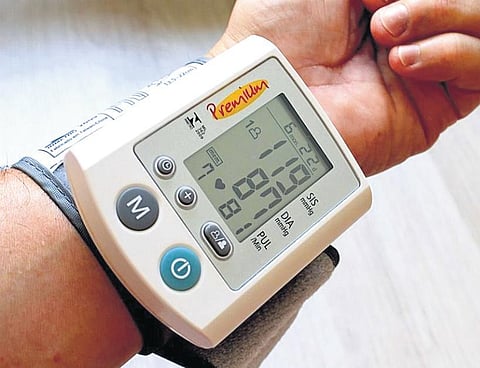

HYDERABAD: World Hypertension Day is observed every May 17th in order to raise awareness and promote hypertension prevention, detection and control. Hypertension is also termed as high blood pressure which is a common condition that affects the body’s arteries. This is meant for those who are dealing with hypertension and how it is supposed to be read. For their knowledge, hypertension is a blood pressure reading of 130/80 mm or Hg or higher, measured in millimeters of mercury. Read on to learn why a person’s blood pressure can increase and what the treatment one should undergo along with the lifestyle tips.
According to Dr Lingaiah Miryala MBBS, MD(Internal Medicine) Consultant General Physician & Diabetologist, AMOR HOSPITALS, around 40% of the nearly 5000 persons screened in Greater Hyderabad region were detected with hypertension and 39.8% were found to be pre-hypertensive. Most of them were between the age group of 35-50. He further added by saying, Off late we are seeing a sharp rise in hypertension cases in younger age groups mostly due to the work stress and lifestyle (reduced activity/zero activity -sedentary lifestyle) people must limit their salt intake to 3-5 grams per day, reducing intake of rice, saturated fats and red meat will help a lot.
Inculcate daily exercise of 30 to 40 minutes a day for five days a week. The activities could be walking, jogging, swimming and training with light weights. Avoid smoking and alcohol. Take a diet rich in fruits and vegetables. Get your BP checked at least once a year preferably by a doctor. Narrow blood vessels, also known as arteries, create more resistance for blood flow. The narrower your arteries are, the more resistance there is, and the higher your blood pressure will be. Over the long term, the increased pressure can cause health issues, including heart disease.
Hypertension typically develops over the course of several years. Usually, you don’t notice any symptoms. But even without symptoms, high blood pressure can cause damage to your blood vessels and organs, especially the brain, heart, eyes, and kidneys. Early detection is important. Regular blood pressure readings can help you and your doctor notice any changes. If your blood pressure is elevated, your doctor may have you check your blood pressure over a few weeks to see if the number stays elevated or falls back to normal levels. Government should conduct more awareness programs and do regular screening of people who are at risk, says Dr Miryala.
Tips to follow to prevent the risk of Hypertension:
Lifestyle tips to lower your risk of hypertension
If you have risk factors for hypertension, you can take steps now to lower your risk for the condition and its complications.
Add fruits and vegetables to your diet
Slowly work your way up to eating more servings of heart-healthy plants. Aim to eat more than seven servings of fruits and vegetables each day. Then aim to add one more serving per day for 2 weeks. After those 2 weeks, aim to add one more serving. The goal is to have 10 servings of fruits and
vegetables per day.
Limit refined sugar
Try to limit the amount of sugar-sweetened foods, like flavored yogurts, cereals, and sodas, you eat on a daily basis. Packaged foods hide unnecessary sugar, so be sure to read labels.
Reduce sodium intake
Keep daily sodium intake between 1,500 milligrams and 2,300
milligrams per day.
The best way to reduce sodium is to cook fresh foods more often and limit the amount of fast food or prepackaged food you eat, which can sometimes be very high in sodium.
Monitor your blood pressure regularly
The best way to prevent complications and avoid problems is to recognise hypertension early.
Keep a log of your blood pressure readings and take it to your regular doctor appointments. This can help us (your doctor) see any possible problems before the condition advances.
Tests:
The tests to check for a cause who is diagnosedwith high blood pressure are as follows:
Ambulatory monitoring: A longer blood pressure monitoring test may be done to check blood pressure at regular times over six or 24 hours. This is called ambulatory blood pressure monitoring. However, the devices used for the test aren’t available in all medical centres. Check with your insurer to see if ambulatory blood pressure monitoring is a covered service.
Lab tests: Blood and urine tests are done to check for conditions that can cause or worsen high blood pressure. For example, tests are done to check your cholesterol and blood sugar levels. You may also have lab tests to check your kidney, liver and thyroid function.
Electrocardiogram (ECG or EKG): This quick and painless test measures the heart’s electrical activity. It can tell how fast or how slow the heart is beating. During an ECG, sensors called electrodes are attached to the chest and sometimes to the arms or legs. Wires connect the sensors to a machine, which prints or displays results.
Echocardiogram: This noninvasive exam uses sound waves to create detailed images of the beating heart. It shows how blood moves through the heart and heart valves.